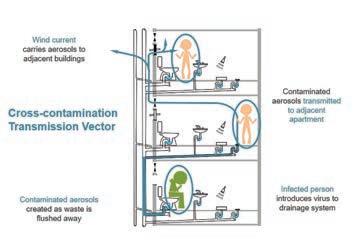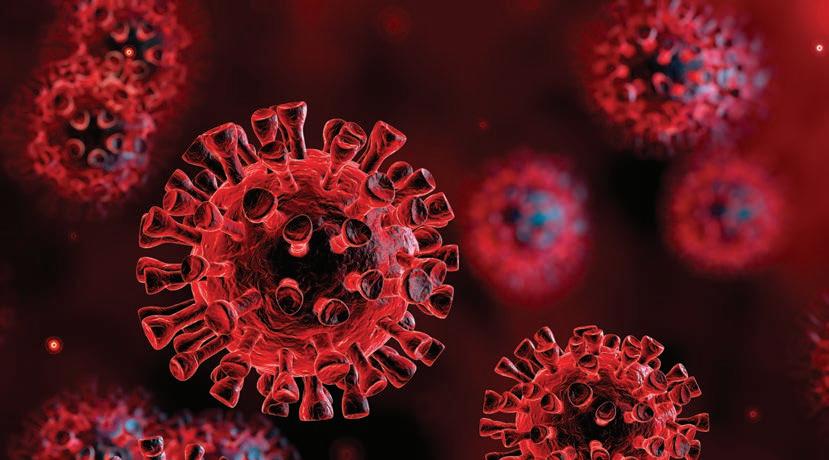
6 minute read
The importance of water trap seals and correct drainage ventilation in 21st century high-rise buildings
The importance of water trap seals and correct drainage ventilation in 21st century highrise buildings
Steven White
With the urbanisation and globalisation of our cities around the world, buildings are being constructed in ever increasing heights to provide accommodation and workspaces for the population. With all people, once the front door off the apartment is closed, there is an illusion that they are protected from the outside world; shutting the doors and windows and within the four walls they are protected from other people and environmental factors, such as pollution Few people understand that that there is a physiological connection through the drainage network and that the barrier to the living space is provided by the water-trap seal in or below their appliances and that this 50mm water seal is what protects them from the outside environment through the building drainage network. This paper looks at why the trap seal is so important to public health.
Water Trap primary purpose
The water trap provides the barrier to protect the occupants from the pathogens originating from the drainage network, the sewerage system and the living space.
The invention of the water trap seal in the 18th century was to prevent the propagation of sewer gases from entering indoor space.
But from the SARS virus outbreak in Amoy Gardens Hong Kong in 2003 the spread of the disease through the water trap seals was across multiple levels and travelled up the drainage system and not down the system, and the virus was in form of aerosolised matter.
This then implies that the water trap seal is the single most important fitting on the drainage network as it prevents the spread of diseases by limiting human exposure to pathogens and allowing the solid and waste transportation system to safeguard public health.
Methods of trap seal loss
The water trap seal is designed to act as a protection device and can be considered as a termination boundary. The water in the seal provides the barrier and by its design it is responsive through water height fluctuations, to pressure differential between the appliance and system side of a trap. It acts in the same manner as a manometer used for measuring.
The performance of the water trap seal is affected by:
1. Induced Siphonage – Induced siphonage occurs upon appliance discharge. Water moves into the vertical stack or flows horizontally past another branch and the motion across this junction pulls air from the nearest branch causing suction of water from the appliance trap seal.
2. Back Pressure – The flow of fluid within the drainage network leads to several simultaneous reactions. One of which is the generation of positive air pressure transients upon the blockage of the air propagation by the water curtain at the base of the stack and offsets within the network.
3. Self-Siphonage – Appliance discharge into a horizontal branch can generate airflows which lead to trap depletion.
4. Evaporation – Considered at 2.5 mm/week however influenced by both temperature and humidity. Evaporation is only relevant when there is no replenishment. During holiday periods or in vacant apartments there will be no replenishment of the water seal and evaporation will happen
5. Wind shear – Due to gusts of wind over the open vent of the stack and a entrainment of air into the dry stack. The pressure fluctuation brought on via the external air pressure forces the movement of the water column towards the appliance side of the trap. The frequency and speed of the gust will cause movement of the seal leading to depletion of the seal.
Transmission routes of infection dieses
Human waste of a healthy or infected person contain several types of pathogens. These can be classified as:
a) Virus (20-300nm) b) Chlamydia (200-1000nm) c) Cickettsiae (300-1200nm) d) Mycoplasmas (125-350nm) e) Bactria (0.8- 15nm) f) Fungi (2-200μm) g) Protozoa (1-50μm) h) Helminth (3nm-10m)

The hardness of a microbe is important as secondary transmission may occur through inanimate objects such as: toilets, sinks, showers or other drainage appliances.
The life span of certain organisms such as Viruses (11-304 days in fresh water), Salmonella (10 days in fresh water), Cholera (30 days in fresh water) Facial Coliforms (10 days in fresh water, suggest that these pathogens as well as many others are present within the drainage system for longer than when they were introduced by the infected person.
For an individual to become at risk of disease transmission, an infectious dose of the disease must be present and make contact with the person.
Typical transmission through the drainage network occurs through waterborne transmission (faecal oral routes for example a bubbling water trap seal), airborne transmission (respiratory droplets for example a dried out or partially filled water trap seal) and insects/arthropods vectors (for example failed pipe joints or toilet pan connector).
Expelled pathogens which are likely to persist after defecation include:
Poliomyelitis, norovirus acute gastroenteritis, giardiasis hepatitis A, hepatitis E, poliovirus, rotavirus (gastroenteritis), shigellosis, typhoid fever, vibrio parahaemolyticus infection, enteroviruses, vibrio cholera (cholera), clostridium difficile, cryptosporidiosis, ascariasis and helicobacter pylori
One or more these pathogens maybe present in the buildings drainage system and with a large multi

occupancy building the risk could be assumed to be higher give the increased number of users of the system.
How best to protect the water trap seals through correct drainage ventilation
The loss or depletion of the water trap seal is not just an inconvenience of smell, there is a potential risk that pathogen transmission may occur if the water barrier is not present.
To mitigate the loss of the water trap seals it is widely accepted that correct ventilation of the water drainage system is required. This is recognised in all standards and codes.
For High-rise and health care buildings with higher risk the water traps seals should be provided with the best protection possible to ensure that the barrier is maintained.
Protecting public health
Since the invention of the traditional water trap seal by Alexander Cummings in 1775 the main purpose of the water seal was to protect occupants of a building from the sewer gases and smells.
Over time primarily low-rise buildings, the potential health risks from a loss of off a water trap seal has been associated with sewer gas ingression and the inconvenience of smells into the living space.
With High-Rise/high usage buildings being constructed today, the potential risk that pathogens may harm occupants of a building is every growing. The amount of different people using the system, and with people travelling and mixing with people from all over the world, the risk of pathogens entering the system will become more common. As was the case with Amoy Gardens in 2003 where it has been proven the building drainage system and the loss of the water trap seal contributed to the loss of life within this building.
The water trap seal is the single most important fitting on the drainage network as it prevents the spread of diseases by limiting human exposure to pathogens and allowing the solid and waste transportation system safeguard public health.
About the Author Steven White
Steven White has contributed his efforts and expertise over 19 years to thousands of projects all over the world. As Aliaxis Technical Director DWV for High-rise Building Solutions, he works with research institutions and manufacturers developing products, to meet the requirements for high-rise drainage ventilation and to validate these technologies, presenting them to the market through bodies such as the WPC, CIBSE, ASPE and CIB W062. Steve is focused on educating and supporting the highrise industry, helping to provide safe drainage systems and the innovations that enable high-rise living.










